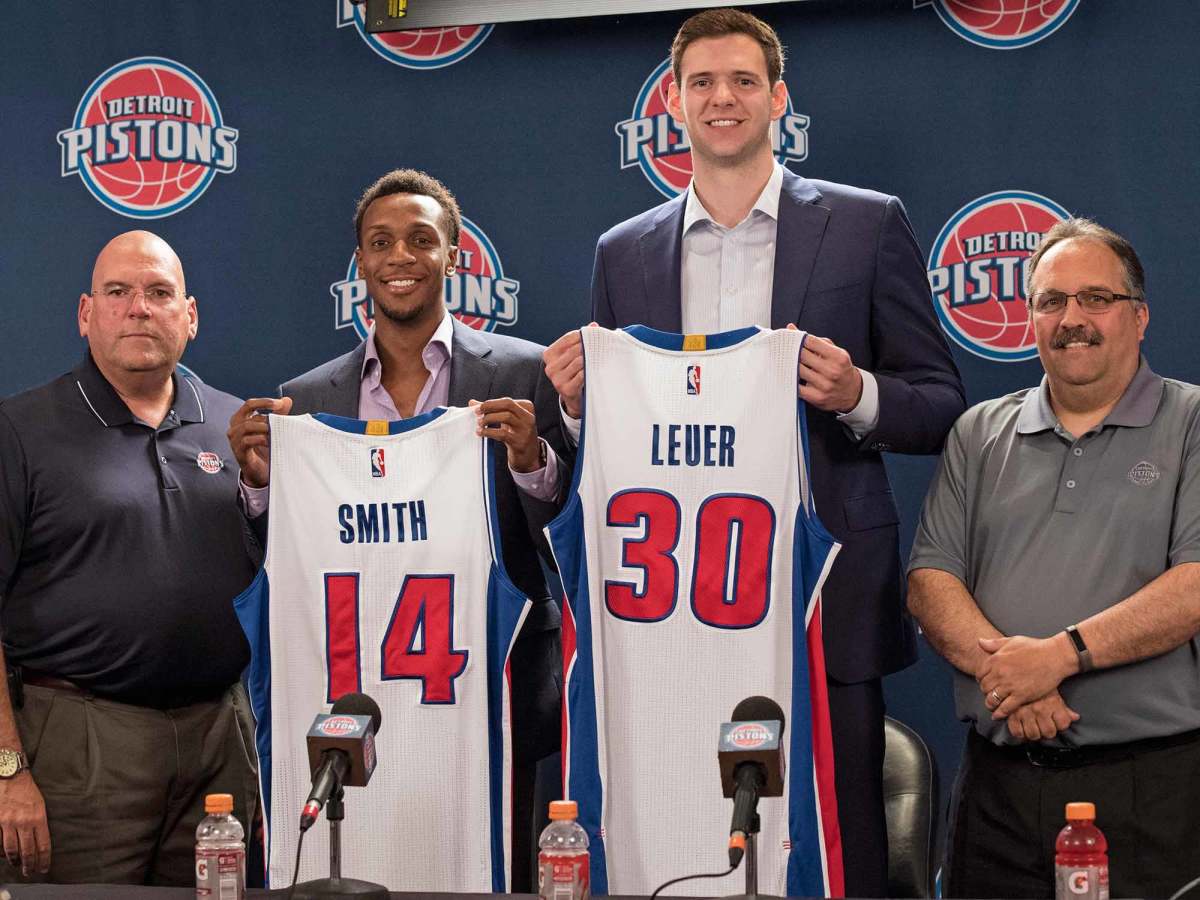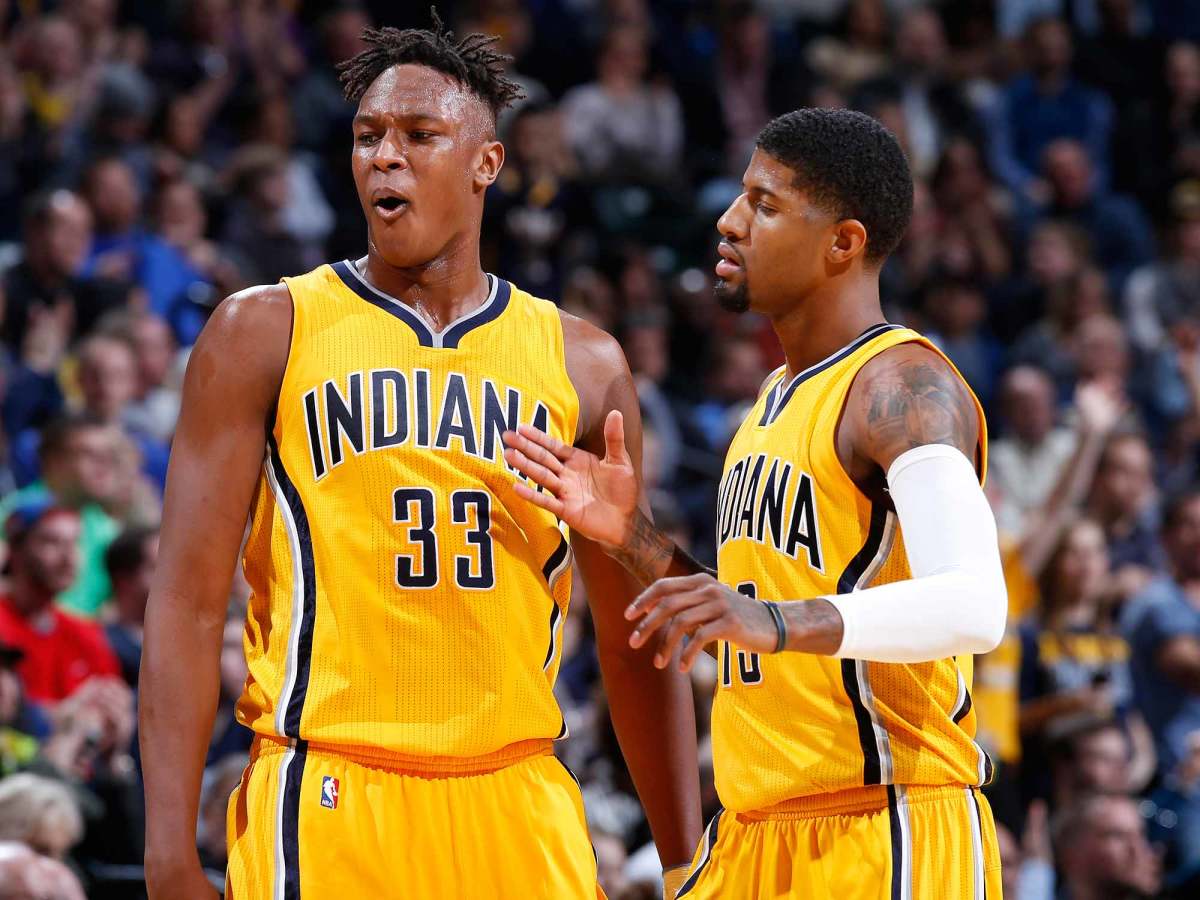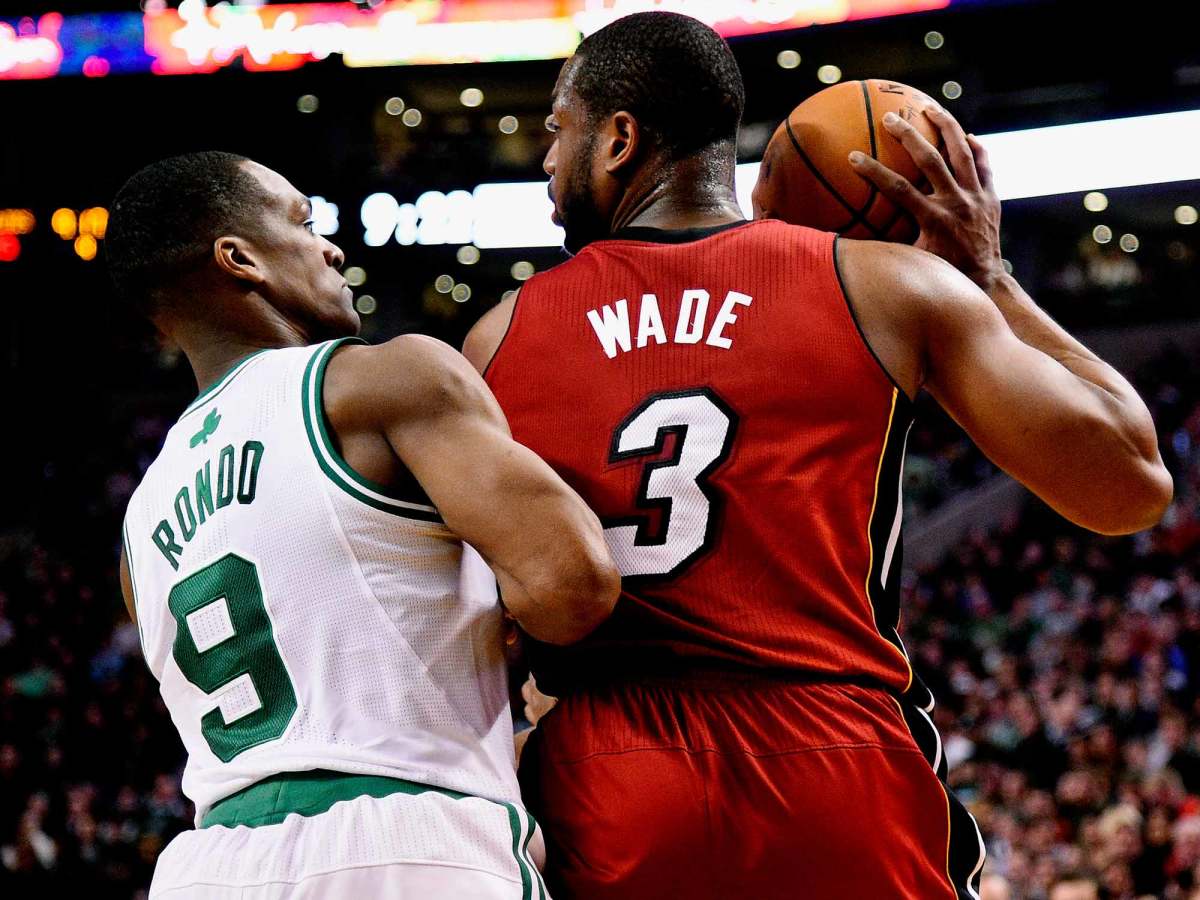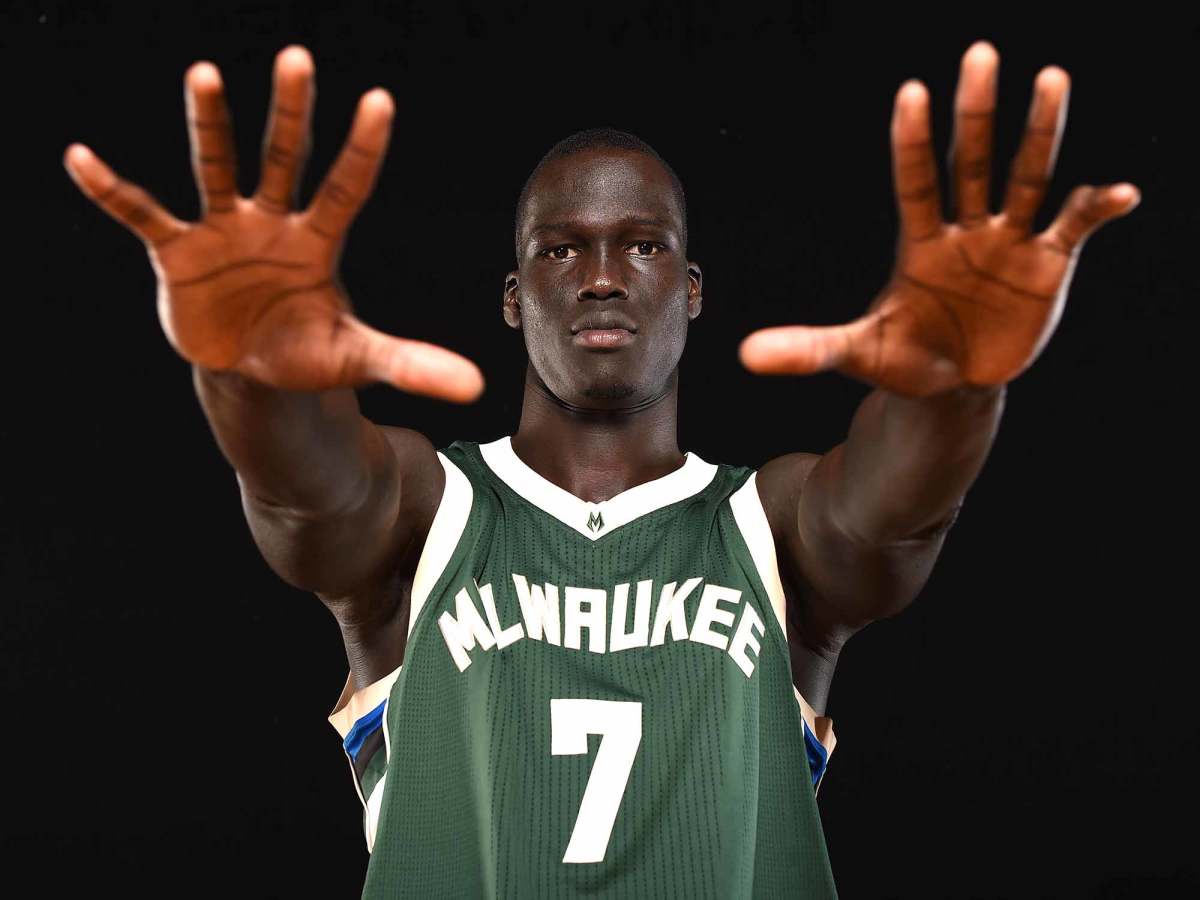NBA off-season grades: Central challengers stay busy, but Cavs maintain dominance

With most of the NBA summer already in the books, SI.com is grading each team's off-season performance and examining their best and worst moves. Today, we dissect the Central Division, which features the reigning champion Cleveland Cavaliers and a host of division rivals undergoing makeovers on the fly.
Cleveland Cavaliers
Best Move: Adding Mike Dunleavy for nothing. This was Cleveland’s only notable off-season activity beyond re-signing LeBron (which was always going to happen). Sure, the move helped facilitate Dwyane Wade's move to a division rival, but getting a reliable, playoff-tested veteran for absolutely no cost was about as good as it gets for a team needing more than anything to keep the band together as they try to repeat. It’s a small move, but a significant one. — Jeremy Woo
Worst Move: The J.R. Smith Saga.As long as it took J.R. Smith to put on his shirt on this off-season, it’s taken even longer for the Cavaliers to re-sign their bombs-away shooting guard. As of Aug. 22, Smith is still unsigned, though most expect him to return to Cleveland. The Cavaliers will need Smith and all other hands on deck for an expected Finals rematch with the loaded Warriors. Smith’s streaky shooting can swing critical games, and Cleveland doesn’t exactly have great options to replace J.R. on the wing, unless they want a full season of an aging Richard Jefferson or brickyImanShumpert. Especially with LeBron specifically calling for Smith’s return, the Cavs should not drag out the J.R. negotiations for much longer. — Rohan Nadkarni
The Skinny: Thanks to LeBron James’s magnificent closing stretch in the Finals, the Cavaliers were able to sidestep what could have been a long, hot summer of trade rumors. Instead of digging in yet again to debates over Kevin Love’s fit and value, Cleveland mostly just got to chill at the beach.
GM David Griffin should savor the terms of James’s latest contract, as it locks in the four-time MVP until July 2018. Meanwhile, assuming J.R. Smith also re-ups as expected, Cleveland will return all seven players who logged at least 50 minutes in the Finals against the Warriors despite losing Matthew Dellavedova and Timofey Mozgov in free agency. The most notable newcomer is Mike Dunleavy, an aging wing who has missed significant time in each of the last two seasons but whose complementary game and three-point range should fit in nicely around Cleveland’s top talents.
LeBron James chases the ghost from Chicago and basketball immortality
As king of the mountain in the East, Cleveland’s summer should be judged not only by its own moves but by how well it was able to maintain its grasp on the conference. The Cavaliers did quite well on that front, as the Raptors endured an expensive sidestep this off-season after making the East finals. The only East playoff team to significantly improve its outlook was the Celtics, but Al Horford, while talented, isn’t going to strike fear in James’s heart. The Cavaliers might have taken a half-step backwards this summer, but the gap between them and everyone else in the East remains vast.
Of course, counteracting the excitement generated by Cleveland’s continued stranglehold on the East is the justifiable concern emanating from Golden State’s Kevin Durant coup. Aside from the Thunder, no one took Durant’s relocation harder than the Cavaliers, who must now prepare themselves for a Warriors team that is both hell-bent on revenge and overflowing with A-list talent. — Ben Golliver
Grade: B–

Detroit Pistons
Best Move: Assembling a bench. Detroit had a nice showing last season, all things considered. But fact that the Pistons managed a playoff trip and stayed healthy while playing Kentavious Caldwell-Pope 40 minutes a night and Marcus Morris for 36 is a small miracle. Stan Van Gundy addressed those issues immediately this summer. With Ish Smith, Jon Leuer and Boban Marjanovic (!) in the mix and rookie Henry Ellenson potentially able to offer some help, Detroit turned one of the East’s thinnest benches into a potential strength. — J.W.
Worst Move: All the frontcourt investment. The Pistons rightfully added depth to their iffy bench with the moves above, but Detroit still desperately lacks outside shooting from its guards. Reggie Jackson is the only regular rotational player who shot respectably from three last year, and he was far from lights out. The additions of Leuer and Ellenson can and will help, but Detroit’s lack of shooting from positions one through three will continue to make Andre Drummond’s life hard in a crowded paint. — R.N.
The Skinny: Detroit’s summer shouldn’t inspire adoration or outrage. Stan Van Gundy and company will run back the entire starting lineup that returned the Pistons to the playoffs in 2016. The only difference? Franchise center Andre Drummond will return on a max contract extension, a steep pay increase that was both deserved and fully anticipated.
The Pistons spent the rest of their off-season energy reshaping their second unit, with questionable and expensive results. Giving Ish Smith $18 million over three years to wipe away the memories of Steve Blake? Worth it. Paying journeyman Jon Leuer $42 million over four years to offer minutes as a stretch four? That’s rough, but it’s arguably better than paying Ryan Anderson twice that to do the same job. Rolling the dice on Boban Marjanovic to the tune of $21 million over three years? That seems excessive, especially because Aron Baynes is already filling the “overpaid former Spurs backup center” slot.
Top 50 games of the 2016-17 NBA season
Putting these moves together, Van Gundy added depth and experience to a young team whose starting lineup collectively enjoyed excellent health last season. Detroit is now better positioned to withstand injuries and it boasts an improved ability to shift between jumbo and stretch looks as needed, but for the second straight summer Van Gundy sunk a heck of a lot of money into a roster whose ceiling remains fairly low.
Kudos to Pistons ownership for agreeing to spend well over $100 million in payroll, but the baby steps this organization is taking towards contention are coming at an exorbitant price. Down the road, Detroit should be able to trade itself out of its expensive cap position if need be. This isn’t a calamity with no way out, but those hoping for prudent, value-driven roster-building will need to look elsewhere. — Ben Golliver
Grade: C

Indiana Pacers
Best move: The Jeff Teague trade. Dealing George Hill for Teague in a three-way trade sounded the alarm for what would be a busy off-season. It also let us know Indiana had designs on being a dark-horse contender in the Eastern Conference, pairing Paul George with a creative scoring point guard for the first time. Teague’s inconsistencies in Atlanta may benefit from a change of scenery and he'll take some of the load off of George over the course of the season. The Pacers now look like a deep, adaptable team that should be in the mix for homecourt advantage come April. Indiana is really trying, and the East is better off for it. — J.W.
Worst move:Firing Frank Vogel. Indiana made some intriguing moves this off-season, but canning Vogel and replacing him with assistant Nate McMillan seems like a lateral move at the very best. Vogel was once a hot young coach, and he's coaxed some great defenses out of some goofy rosters over the years. Remember all the injuries Indiana sustained the season before last? Vogel largely kept that team competitive even without Paul George. If Larry Bird wanted to replace Vogel, fine, but why hire his assistant—with a .514 winning percentage in 930 games—and not go after an up-and-comer? — R.N.
The Skinny: This was a “change for the sake of change” summer for Pacers president Larry Bird, who dumped his coach, his longtime point guard and his starting center (Ian Mahinmi) in hopes of fashioning a more potent and entertaining offense that will make full use of Paul George’s superstar talent. In fact, this was Year Two of Bird’s deconstruction/reconstruction of his former Eastern Conference finalist squad; after ditching Roy Hibbert and losing David West in 2015, this summer’s moves vaguely continue on that “younger and more dynamic” goal path.
Thaddeus Young arrived via trade with Brooklyn at a good price, on a good contract and as a good positional fit. Jeff Teague steps in for Hill, improving Indiana’s playmaking at the point guard position. Al Jefferson takes Mahinmi’s roster spot, a swap should allow 2015 rookie Myles Turner sufficient room to grow as a full-time starter, while also implanting Jefferson as a second-unit tent post. This should be a win-win given Turner’s high ceiling and Jefferson’s advancing age.
Thon Maker benefiting from perspective in rare preps-to-pros transition
But there are plenty of potential stumbling blocks to consider. Can McMillan deliver on Bird’s expectations for the offense given that his last head coaching job, with the Blazers in 2012, saw him play at a snail’s pace? Will the Teague/Monta Ellis backcourt combination give away any offensive progress on the defensive end? How eager is Bird to fork over big money to Teague, a fairly average starter, if he turns in career-year numbers during his contract season? How badly will Indiana’s new-look frontline miss Mahinmi’s rim protection? Can Jefferson hold up, and can he keep up if the Pacers try to push things a bit?
Bigger picture, the concern is that the Pacers have spent another off-season treading water as George’s first crack at unrestricted free agency (he can opt out in 2018) gets closer and closer. And even with all the activity, it’s hard to make the case that Indiana took a full step forward in the standings for 2016-17, which could require another shakeup next summer. The addition of Young and the lack of a truly horrendous contract decision earns Bird slightly better than a passing mark, but little more. — B.G.
Grade: C+

Chicago Bulls
Best move: Pulling Dwyane Wade out of thin air. After drafting a ball-dominant guard (Denzel Valentine) and then signing another ball-dominant guard (Rajon Rondo) to go with their other ball-dominant guard (Jimmy Butler), it became glaringly obvious that the organization had no idea Dwyane Wade was going to fall into its lap. From an X’s and O’s standpoint, this is an extraordinarily muddled backcourt. But in terms of saving face after losing two franchise icons in Derrick Rose and Joakim Noah, adding Wade was about as good as it could have gotten for Chicago. Throwing Wade’s homecoming into the narrative mix makes for a beautiful PR opportunity and a slim chance they can overachieve and make it work. — J.W.
Worst move: Blowing up the rebuild.The departures of Rose and Noah made it seem the Bulls were finally ready to detach from the Thibodeau era and build around Jimmy Butler. Instead, Chicago added pricey, aging veterans in Wade and Rondo. What is the plan here? The moves neither push the Bulls closer to the top of the conference nor help Butler fully emerge as the leader of the team. Chicago simultaneously handcuffed its only potential superstar and forced Fred Hoiberg to run his fast-paced, modern offense with old guards who don’t shoot well. Maybe this all comes together for a surprising season, but Chicago’s decision to reverse course mid off-season is baffling at best, and disastrous at worst. — R.N.
The Skinny: No team can touch Chicago’s summer when it comes to the sheer volume of polarizing decisions. Really, the Bulls’ off-season was catnip for talking heads and overly invested bloggers alike. As the questionable decisions piled up, the logic driving them dwindled and dwindled, to the point that it’s no longer clear exactly what Chicago was trying to accomplish.
Moving on from Rose, Noah and Pau Gasol were all defensible calls. By trading Rose, Chicago was able to hand the keys to Jimmy Butler and add a center in Robin Lopez who, while ill-fitting in an up-tempo style, at least brings something to the table. By watching as the Knicks overpaid for Noah, Chicago avoided living in the past, a common mistake for teams that enjoy sustained success. By parting with Gasol, Chicago seemed to acknowledge that it couldn’t quite work around his defensive limitations and that it could no longer offer the aging Spaniard a chance to contend for a title.
The messiest breakups in NBA history
Unfortunately, Chicago’s biggest additions—Rajon Rondo and Dwyane Wade—wound up undoing much of that work. Instead of targeting talents who can space the court and help make Butler’s life easier, Chicago opted for “name” free agents who are non-shooters and who need the rock to be successful. Striking a successful balance on offense between these three will be like playing Jenga on a teeter-totter. Be ready to hide your eyes, as the Rondo/Wade pairing could be even worse on defense.
• Dwyane Wade on being an underdog his entire life: 'I embraced that'
In sum, Chicago looks like a team that knew it needed a new chapter but didn’t have the foresight to actually write it. The Bulls are left praying for good health for Wade, a good attitude from Rondo, and a good degree of patience from Butler, who is surely left wondering what the plan is going forward, especially given his presence in trade rumors around the draft. Fans hoping that management was serious about building a younger and more athletic team around Butler must now duck their heads from the dozens of bricks that are sure to be hoisted next season, while wondering if Hoiberg will be cast as the fall guy if this poorly-conceived roster doesn’t return to the playoffs and respectability after a disappointing 2015-16 season. — Ben Golliver
Grade: D–

Milwaukee Bucks
Best Move: Signing Matthew Dellavedova. I admit I really didn’t get this deal at first glance, but after watching the Bucks make small moves and double down on their core pieces, the addition of 25-year-old Delly, fresh off a strong Olympics, makes sense. It’s not clear if he’ll start at point guard, but imagining lineups with Delly hounding ballhandlers and Giannis Antetokounmpo and Khris Middleton covering the wings is kind of enticing. Think about what Milwaukee did defensively in the playoffs two years ago. They’re at least inching closer to that. Don’t fret over the lack of splashy moves here—this season was always going to be about watching Giannis and Jabari bloom. — J.W.
Worst Move: Drafting Thon Maker. It doesn’t feel great to pile on here, but the Bucks’ selection of Maker at No. 10 in June's draft is difficult to understand. Age controversy aside, how will Maker fit in with the Bucks’ roster? His thin frame will make it hard to bang with centers while his lack of shooting could make him a liability at power forward. In Milwaukee’s defense, the Bucks didn’t exactly pass up on any sure bets, and if you squint hard enough you can see Maker’s length helping Milwaukee’s defense turn into a terrifying swarm of limbs at some point in the future. For now, we’ll have to wait and see if the Bucks have completely squandered the momentum of their 2015 playoff run by botching their lottery pick. — R.N.
The Skinny: For all the promise and hype, Milwaukee suffered from a number of fatal errors that sent it spiraling back to the lottery last season. The Bucks ranked dead last in made threes, they started to realize that that Michael Carter-Williams isn’t going to develop into the type of player they hoped when they traded for him, and they found out that a change of scenery wasn’t enough to magically correct Greg Monroe’s frontcourt fit issues.
This summer brought non-answers or very partial answers to those problems. On the shooting front, Milwaukee tapped Mirza Teletovic, whose three-year, $30 million contract looks good compared to more lucrative deals given to other stretch fours. Unfortunately, Teletovic’s offensive impact numbers far exceed his defensive impact numbers, which will force coach Jason Kidd to get extra creative in constructing functional lineups that involve his new addition.
The point guard quagmire continues, with talk that Giannis Antetokounmpo might function as a one, which would help alleviate Milwaukee’s frontcourt logjam. Milwaukee’s best lineup might feature a perimeter trio of Antetokounmpo, Khris Middleton and free-agent signing Matthew Dellavedova. Dellavedova is useful in a number of ways, but he’s a modest upgrade over Milwaukee’s back-up guards from last year (Jerryd Bayless, O.J. Mayo, Greivis Vasquez).
Thon Maker benefiting from perspective in rare preps-to-pros transition
The expensive arrival of Dellavedova is a good and grim reminder that the Bucks traded the second-round pick that became Norman Powell (one of the 2015 draft’s breakout talents) and a 2017 first-round pick for Vasquez in June 2015. For what it’s worth, Vasquez signed with the Nets on a one-year, $4.3 million contract after playing just 23 games due to injury. Needless to say, Milwaukee would have been way, way better off with Powell or their 2017 pick, let alone both, rather than getting virtually nothing from Vasquez only to double down on Dellavedova. The Vasquez trade looked bad the moment it was executed, and it turned out even worse than feared.
For now, Milwaukee goes forward with Monroe in the fold, although it does so after dumping a whopping four-year, $52 million contract on center Miles Plumlee’s doorstep. That means Milwaukee has three centers—Monroe, Plumlee and John Henson—who are each earning eight-figure salaries, and none of the three looks like an ideal long-term solution. Don’t forget: Milwaukee surprisingly used its 2016 lottery pick on Thon Maker, a multi-year project whose best position is probably as a second-unit five. Clearly, something will have to give, and probably sooner rather than later.
Progress for the Bucks in 2016-17 will be driven by the development of Antetokounmpo and Jabari Parker. With the possible exception of Dellavedova, there’s a decent chance that none of Milwaukee’s off-season moves makes that development occur more quickly and easily. That, coupled with the as yet unresolved issues at the one and five, leaves Milwaukee behind the curve this summer. — Ben Golliver
